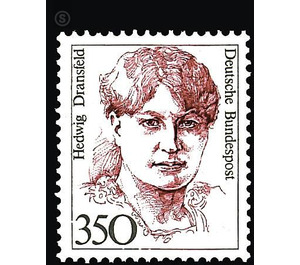Postage stamp: Women of German History - Germany / Federal Republic of Germany 1988 - 350 Pfennig
Theme: Health & Human
| Country | Germany / Federal Republic of Germany |
| Issue Date | 1988 |
| Face Value | 350.00 |
| Color | brown white |
| Perforation | K 14 |
| Printing Type | 2-color Typography |
| Stamp Type | Postage stamp |
| Item Type | Stamp |
| Chronological Issue Number | 1266 |
| Chronological Chapter | GER-BRD |
| SID | 136767 |
| In 45 Wishlists | |
With »Women of German History« the Deutsche Bundespost replaces the series »Industry and Technology« begun in 1975/76. The new series is intended to help raise awareness of women's achievements in society. Up to the 60 Pf value (Dorothea Erxleben) - it now appears in the issue »Deutsche Bundespost Berlin« - the other postage stamps are issued on the same day in the issues »Deutsche Bundespost« and »Deutsche Bundespost Berlin«. Hedwig Dransfeld was born on February 24, 1871 in Hacheney near Dortmund. She was a full orphan since the age of 8 and grew up with her grandmother. After her schooldays in the collegiate school, where she already attracted attention through extraordinary intelligence and discipline, she completed a training as a teacher at the Royal Teachers' Seminar in Paderborn, which she completed in 1890 with honors. Already in the 2nd year of the seminar she was seriously ill with bone tuberculosis. Frequent surgery followed, the left arm was amputated, and in the following years she was repeatedly tied to the bedside for weeks and months. Nevertheless, she continued her education in addition to her work as a teacher at the Ursuline School in Werl. In 1892 she passed the supplementary examination for middle and high schools. In 1897 she passed the exam for school governors. From 1904 to 1911 she took over the management of a Lyceum with scientific training classes in Werl. This task is related to their multiple efforts to give young women self-confidence and to enable them to prepare for life with study and work. In addition to her pedagogical work, she has published volumes of poetry and numerous books for girls. In 1904, she took over the writing of THE CHRISTIAN WOMAN, a "magazine for higher female education and Christian women's activity in family and society," which in 1905 became the federal organ of the Catholic German Women's Association. In November 1912, she became federal chairman of the Catholic German Women's Association, which was founded in 1903 and corresponded to her ideas regarding the Catholic women's movement. Already in February 1912 she described the location of the association as follows: "He is one of the non-ecclesiastical associations, but they want to orient themselves in worldview questions within their confession of the church doctrine, because they stand in this direction in the duty of their conscience and their conviction It speaks in favor of Hedwig Dransfeld's independence that, despite her deep involvement in the Catholic faith, she did not integrate this association into an ecclesiastical institution. Their efforts to enable education not only for a particular class, but for all the women of the people, their efforts to open up higher education to women, the founding of the first social women's school in the Catholic area (1916), the comprehensive political education of the Women in view of women's suffrage, but without making propaganda for its introduction, characterize their commitment to the interests of women. She has always endeavored to pick up on the problems that are coming up and solve them according to the times. In the middle of the First World War, in 1916 she summoned the women of the Catholic German Women's Association in the Reichstag in Berlin to a general assembly, which put them in perspective on the future tasks under the theme "The woman as a co-creator in the new Germany". It was therefore natural for them, when in 1918 women were given the right to vote, to join the National Assembly and then the Reichstag as a member of the center group. Again, she remained true to herself as she voted against her own faction for the abolition of the death penalty. Her parliamentary activities focused on issues of protection of minors, pensions, family protection and psychiatric care. In addition to her work as a deputy, her tireless advertising was aimed at the establishment of a women's peace church as the response of women to the catastrophe of war. The completion of this church on May 5, 1929, she has not seen. Hedwig Dransfeld died at the age of 52, on March 13, 1925 in Werl in Westphalia. (Texts: Federal Ministry for Posts and Telecommunications, Bonn, Dr. E. Gerresheim, Philosophy Department of the University of Bonn, Mario Bungert-Kroemer, Friedrich Ebert Foundation, Archive of Social Democracy, Bonn, Commissariat of German Bishops, Catholic Office Bonn)


